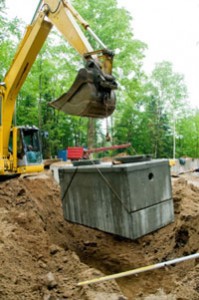If your Orlando home or business has a septic tank, beware! The septic system is a fragile environment that can be easily damaged by some common plumbing practices. Home Guides helps diagnose some of these practices, trouble shoot problems, and has easy solutions. Contact Orlando Septic Services with any questions or for a quote.
How a Septic System Works
 The heart of a septic system is the tank, which has inlet and outlet ports located at its top. Waste water flows into the inlet and solids settle to the bottom while the outflow drains or gets pumped into a drainage field and leaches into the ground. A healthy system has a tankful of bacteria that are constantly breaking down solid waste, and it has a porous leach field capable of absorbing all the water that flows out of the tank. Like any plumbing system, clogs can always develop in the pipes, and you can usually clear them. When you can’t, they may signify root blockages or leach field failure.
The heart of a septic system is the tank, which has inlet and outlet ports located at its top. Waste water flows into the inlet and solids settle to the bottom while the outflow drains or gets pumped into a drainage field and leaches into the ground. A healthy system has a tankful of bacteria that are constantly breaking down solid waste, and it has a porous leach field capable of absorbing all the water that flows out of the tank. Like any plumbing system, clogs can always develop in the pipes, and you can usually clear them. When you can’t, they may signify root blockages or leach field failure.
Controlling Tank Inflow
If you own a septic system, you probably know that you shouldn’t put toxic waste, such as household chemicals or paint, into the drains. Both increase the amount of solid matter in the tank — the chemicals by killing the bacteria and the paints, oils and greases by remaining undissolved. That undissolved material eventually finds its way into the leach field and can make the soil less porous. Leaking faucets or toilets also damage the leach field. They can send hundreds of excess gallons of water through the system that essentially water log the leach field.
Diagnosing Problems
If a toilet or sink backs up, it could be a sign of septic failure, or it could simply be a clog. It’s probably the latter if only one drain backs up. You should always clear clogs with a plunger, a snake or with enzymes because caustic cleaners kill bacteria. If the blockage affects more than one fixture, and you can’t clear it, look inside the tank. If the water level is too high, the leach field is probably blocked. If so, you may see water pooling around the tank even before you look inside. If the water level is normal or low, however, tree roots may be blocking the pipes between the house and the tank.
Solutions
You need to pump your septic tank every three to five years to keep solid matter out of the leach field, and if a blockage develops, you must isolate the cause before you can do anything. Roots can block leach field pipes as well as waste pipes, so an inspection of the landscaping is in order. Diagnosing root problems and clearing the roots is often a job for a professional, although you may be able to clear roots in the waste lines with chemicals. If roots aren’t the problem, you may be facing the hard reality that your leach field has failed. The solution is to expand the field or move it to a different location.


